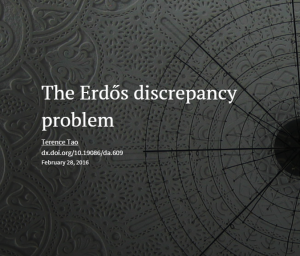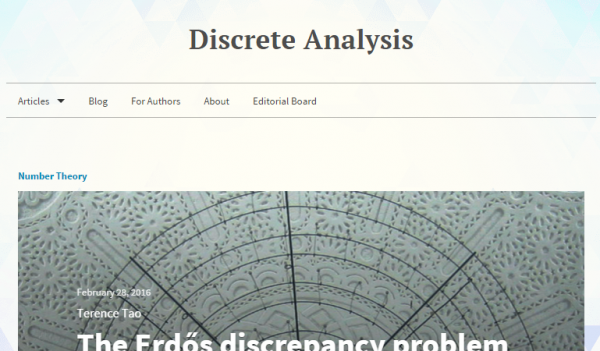Discrete Analysis, a new open-access journal for articles which are “analytical in flavour but that also have an impact on the study of discrete structures”, launched this week. What’s interesting about it is that it’s an arXiv overlay journal founded by, among others, Timothy Gowers.
What that means is that you don’t get articles from Discrete Analysis – it just arranges peer review of papers held on the arXiv, cutting out almost all of the expensive parts of traditional journal publishing. I wasn’t really prepared for how shallow that makes the journal’s website – there’s a front page, and when you click on an article you’re shown a brief editorial comment with a link to the corresponding arXiv page, and that’s it.
For more on how the traditional publishing industry isn’t serving mathematicians and scientists, see The Cost of Knowledge campaign, also set up by Gowers, which called for a boycott of Elsevier to protest their high prices and restrictive copyright policies.
But that’s all it needs to do – the opinion of Gowers and co. is that the only real value that journals add to the papers they publish is the seal of approval gained by peer review, so that’s the only thing they’re doing. Maths papers tend not to benefit from the typesetting services traditional publishers provide (or, more often than you’d like, are actively hampered by it).
One way the journal is adding value beyond a “yes, this is worth adding to the list of papers we approve of” is by providing an “editorial introduction” to accompany each article. These are brief notes, written by members of the editorial board, which introduce the topics discussed in the paper and provide some context, to help you decide if you want to read the paper. That’s a good idea, and it makes browsing through the articles – and this is something unheard of on the internet – quite pleasurable.
 A typical background image on an article – the sort of picture that looks vaguely mathematical but in a subtle way. I wonder how long they can keep that up.
A typical background image on an article – the sort of picture that looks vaguely mathematical but in a subtle way. I wonder how long they can keep that up.
Each article also has a stock photo attached to it to liven up the page. Now, this is a pure maths journal, so the chances of finding an attractive photo which in any way relates to the content of the paper are extremely slim, so the editors have just chosen pretty generic stock photos. That doesn’t make any sense from a utilitarian perspective, but it does make an aesthetic improvement, and at least it’s not more ruddy cumulonumbers! When’s the last time a journal publisher thought about aesthetics? As Gowers notes in his blog post announcing the launch of Discrete Analysis, this makes a stark contrast with a previous open-access journal he was involved in, Forum of Mathematics, whose website looks like the 90s fell asleep on the textured gradient button.
Discrete Analysis is being hosted by Scholastica, a startup founded by some University of Chicago graduates who have developed a journal management platform. They’re only charging $10 per submission, which the editors of Discrete Analysis are currently covering with their own funds, making the journal free for both readers and authors.
This set-up does raise a few worries – the cost of hosting papers isn’t zero, it’s just been externalised to arXiv; and what if Scholastica raise their per-submission prices, or change their system in some way? The first worry shouldn’t cause too much lost sleep – the arXiv was going to host these papers anyway, and it does so very cheaply. The second one is a little more concerning – hot new startups come and go like boy bands. I’m not sure what the copyright situation is with the editorial comments – I can’t find a copyright or licence notice anywhere on the journal’s website – however, Gowers has confirmed on Google+ that the journal name doesn’t belong to Scholastica, so presumably everything could easily be moved on somewhere else if the need arose.
More information
The journal Discrete Analysis
Discrete Analysis launched at Gowers’ Weblog

One Response to “The arXiv overlay journal Discrete Analysis has launched”